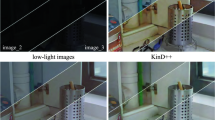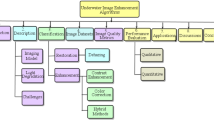Abstract
Underwater images are prone to suffer from color distortion and low visibility because of the strong light attenuation. The traditional dark channel prior (DCP) method tends to fail when used for underwater image restoration. By exploring the differences in light attenuation between atmosphere and water, we propose an innovative image restoration method—optimized red dark channel prior (ORDCP) which adds a valid contrast indicator. In addition, we set double threshold judgments to determine the main color tone and calculate red channel transmission map. After getting the two estimated parameters including transmission maps and background light, we can restore underwater images using conventional underwater imaging model. The subjective evaluations indicate that the algorithm we proposed has better performance in terms of saturation, contrast and images edge details. What’s more, the results of objective evaluation metrics show that the performances maximally increase by 32.32% in underwater images such as the ship and stone. The conclusion can be drawn that the proposed method is able to remove the noise and blur caused by complicated underwater environment and performs favorably against the state-of-the-art algorithms.







Similar content being viewed by others
References
Adrian G, David P, Artzai P, Aitor AG (2015) Automatic Red-Channel underwater image restoration. J Vis Commun Image Represent 26:132–145
Amer KO, Elbouz M, Alfalou A, Brosseau C, Hajjami J (2019) Enhancing underwater optical imaging by using a low-pass polarization filter. Opt Express 27(2):621–643
Buchsbaum G (1980) A spatial processor model for object color perception. J Franklin Inst-Eng Appl Math 310(1):1–26
Chang H (2020) Single underwater image restoration based on adaptive transmission fusion. IEEE Access 86(3):50–62
Chen X, Yu J, Kong S, Wu Z, Fang X, Wen L (2020) Towards Real-Time advancement of underwater visual quality with GAN. IEEE Trans Ind Electron 66(12):50–59
Cheng CY, Sung CC, Chang HH (2015) Underwater image restoration by red-dark channel prior and point spread function deconvolution. presented at 2015 IEEE International Conference on Signal and Image Processing Applications (ICSIPA), pp 110–115
Dai C, Lin M, Wu X, Wang Z, Guan Z (2019) Single underwater image restoration by decomposing curves of attenuating color. Opt Laser Technol:1–11
De Oliveira JF, Duarte GA, Codevilla Moraes F, Drews Jr P, Silvia SCB (2019) Single image restoration for participating media based on prior fusion. IEEE Comput Graph Appl 39(1):71–83
Fattal R (2008) Single image dehazing. ACM Trans Graph 27 (3):721–729
Finlayson GD, Trezzi E (2004) Shades of gray and color constancy. presented at Color Imaging Conference (CIC), Arizona, pp 37–41
Gillis DB (2020) An underwater target detection framework for hyperspectral imagery. IEEE J Sel Top Appl Earth Observ Remote Sens 13:1798–1810
Gordon HR (1989) Dependence of the diffuse reflectance of natural waters on the sun angle. Limnol Oceanogr 34(8):1484–1489
Gould RW, Arnone RA, Martinolich M (1999) Spectral dependence of the scattering coefficient in case 1 and case 2 waters. Appl Opt 38(12):77–83
Guo Q, Xue L, Tang R, Guo L (2017) Underwater image enhancement based on the dark channel prior and attenuation compensation. J Ocean Univ China 16(5):57–65
Han PL, Liu F, Wei Y, et al. (2020) Optical correlation assists to enhance underwater polarization imaging performance. Opt Lasers Eng 134:1–6
He KM, Sun J, Tang XO (2010) Guided image filtering. presented at European Conference on Computer Vision (ECCV), pp 1–14
He KM, Sun J, Tang XO (2011) Single image haze removal using dark channel prior. IEEE Trans Pattern Anal Mach Intell 33(12):2341–2353
Hou G, Li J, Wang G, Pan Z, Zhao X (2020) Underwater image dehazing and denoising via curvature variation regularization. Multimed Tools Appl:1–21
Hou G, Li J, Wang G, Yang H, Huang B, Pan Z (2019) A novel dark channel prior guided variational framework for underwater image restoration. J Vis Commun Image Represent:1–25
Jaffe JS (1990) Computer modeling and the design of optimal underwater imaging systems. IEEE J Ocean Eng 15(2):101–111
Joel D.O, Gaya FC, Duarte AC, Botelho S (2016) General Participative Media Single Image Restoration. https://researchgate.net/publcatlon/301842046
Liu YZ, Chi KC, Lin S (2020) Underwater image restoration based on background light estimation and transmittance optimization. Laser Optoelectron:1–14
Luo Y, Qin J, Xiang X, Tan Y, Liu Q, Xiang LY (2020) Coverless real-time image information hiding based on image block matching and dense convolutional network. J Real-Time Image Proc 17:125–135
Łuczyński T, Birk A (2018) Underwater Image Haze Removal and Color Correction with an Underwater-ready Dark Channel Prior. IEEE Oceans 1:1–8
Ma XM, Chen ZH, Feng ZP (2019) Underwater image restoration through a combination of improved dark channel prior and gray world algorithms. J Electron Imaging 28(5):1–10
Mathias A, Samiappan D (2019) Underwater Image Restoration based on Diffraction Bounded Optimization Algorithm with Dark Channel Prior. Optik 19(2):1–8
Nakatani T, Yoshida H, Hyakudome T et al (2013) Dives of cruising-AUV “JINBEI” to methane hydrate area on Joetsu knoll and Umitaka Spur, 2013 OCEANS, San Diego, pp 1–5
Panetta K, Gao C, Agaian S (2016) Human-Visual-System-Inspired Underwater image quality measures. IEEE J Ocean Eng 41(3):541–551
Perez J, Bryson M, Williams SB, Sanz PJ (2020) Recovering depth from still images for underwater dehazing using deep learning. Sensors 20(16):1–16
Song W, Wang Y, Huang D, Liotta A, Perra C (2020) Enhancement of underwater images with statistical model of background light and optimization of transmission map. IEEE Trans Broadcast 66(1):153–169
Tang ZQ, Zhou B, Dai XZ, Gu HT (2018) Vision enhancement of underwater vehicle based on improved DCP algorithm. Robot 40(2):222–230
Xu H, Tan Y, Wang W, Wang G (2020) Image dehazing by incorporating markov random field with dark channel prior. J Ocean Univ China 19 (3):551–560
Yang S, Chen Z, Feng Z, Ma X (2020) Underwater image enhancement using scene Depth-Based adaptive background light estimation and dark channel prior algorithms. IEEE Access 1(3):318–327
Yang AP, Qu C, Wang J (2018) Image sharpening algorithm based on underwater imaging model. J Electron Inf Technol 40(2):298–305
Yang M, Sowmya A (2015) An underwater color image quality evaluation metric. IEEE Trans Image Process 24(12):62–71
Yang M, Sowmya A, Wei Z, Zheng B (2020) Offshore underwater image restoration using Reflection-Decomposition-Based transmission map estimation. IEEE J Ocean Eng 45(2):521–533
Yu H, Li X, Lou Q, Lei C, Liu Z (2020) Underwater image enhancement based on DCP and depth transmission map. Multimed Tools Appl:1–48
Zhang S, Gong X, Nian R, He B, Wang Y, Lendasse A (2017) A depth estimation model from a single underwater image with non-uniform illumination correction. presented at OCEANS 2017 – Aberdeen, pp 1–5
Zhao XW, Jin T, Qu S (2015) Deriving inherent optical properties from background color and underwater image enhancement. Ocean Eng 94:163–172
Acknowledgements
The research work is supported by the The National Natural Science Foundation of China(61801270), The National Natural Science Foundation of China (61471224) and Shandong Province Key R&D Program (Public Welfare Project) (2018GHY115022). Many thanks to the anonymous reviewers for their constructive comments and valuable suggestions.
Author information
Authors and Affiliations
Corresponding author
Additional information
Publisher’s note
Springer Nature remains neutral with regard to jurisdictional claims in published maps and institutional affiliations.
Declaration of Competing Interest
The authors declare that they have no known competing financial interests or personal relationships that could have appeared to influence the work reported in this paper.
Rights and permissions
About this article
Cite this article
Wu, Q., Guo, Y., Hou, J. et al. Underwater optical image processing based on double threshold judgements and optimized red dark channel prior method. Multimed Tools Appl 80, 29985–30002 (2021). https://doi.org/10.1007/s11042-021-11200-8
Received:
Revised:
Accepted:
Published:
Issue Date:
DOI: https://doi.org/10.1007/s11042-021-11200-8




